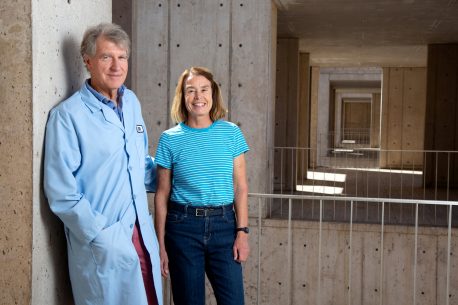
November 13, 2018
Salk research focuses on the development of compounds that may protect against the diseases of aging, such as Alzheimer’s
Salk research focuses on the development of compounds that may protect against the diseases of aging, such as Alzheimer’s
LA JOLLA—Old age is the greatest risk factor for many diseases, including Alzheimer’s disease (AD) and cancer. Geroprotectors are a recently identified class of anti-aging compounds. New Salk research has now identified a unique subclass of these compounds, dubbed geroneuroprotectors (GNPs), which are AD drug candidates and slow the aging process in mice.
“The argument for geroprotectors is that if one can extend the lifespan of model organisms, such as mice, and translate this effect to humans, then you should be able to slow down the appearance of many diseases that are associated with aging, such as Alzheimer’s, Parkinson’s, cancer and overall frailty,” says first author Dave Schubert, Salk professor and head of Salk’s Cellular Neurobiology Laboratory.

Click here for a high-resolution image
Credit: Salk Institute
The study, which appeared in the journal Trends in Pharmacological Sciences, on November 13, 2018, was conducted in collaboration with Salk Senior Staff Scientist Pamela Maher, whose lab is in the Cellular Neurobiology department and who is the study’s senior author.
The team started with two chemicals found in plants that have demonstrated medicinal properties: fisetin, a natural product derived from fruits and vegetables, and curcumin, from the curry spice turmeric. From these, the team synthesized three AD drug candidates based upon their ability to protect neurons from multiple toxicities associated with the aging brain. The lab showed that these three synthetic candidates (known as CMS121, CAD31 and J147), as well as fisetin and curcumin, reduced the molecular markers of aging, as well as dementia, and extended the median lifespan of mice or flies.
Importantly, the group demonstrated that the molecular pathways engaged by these AD drug candidates are the same as two other well-researched synthetic compounds that are known to extend the lifespan of many animals. For this reason, and based on the results of their previous studies, the team says fisetin, curcumin and the three AD drug candidates all meet the definition of being geroneuroprotectors.
The group is now focusing on getting two GNPs into human clinical trials. The fisetin derivative, CMS121, is currently in the animal toxicology studies required for FDA approval to start clinical trials. The curcumin derivative, J147, is under FDA review for allowance to start clinical trials for AD early next year. The group plans to incorporate biochemical markers for aging into the clinical trials to assay for potential geroprotective effects.
“Since we found that the natural products curcumin and fisetin are also GNPs and commercially available as supplements, they could provide some therapeutic benefits right now,” says Maher.
Other studies in the lab are determining whether these compounds have effects on organs outside of the brain. “If these drugs have benefits for other body systems, such as maintaining kidney function and overall muscle health, they could be used in additional ways to treat or prevent the diseases of aging,” Schubert says.
The investigators say that the discovery of these AD drug candidates validates the drug discovery model they have developed as a plausible method for identifying additional GNP compounds that will help promote healthy aging. This could greatly accelerate the pipeline for drugs to treat the diseases of aging for which there are currently no cures.
Other researchers on the paper were Antonio Currais and Joshua Goldberg of Salk, Kim Finley of San Diego State University, and Michael Petrascheck of The Scripps Research Institute.
This work was funded by National Institutes of Health grants RO1 AG046153, RF1 AG054714 and R41AI104034; the California Institute of Regenerative Medicine; the Edward N. & Della Thome Memorial Foundation; the Paul F. Glenn Center for Aging Research at the Salk Institute; and the Bundy Foundation. Schubert is an unpaid science advisor for Abrexa Pharmaceuticals, which is moving J147 into clinical trials.
JOURNAL
Trends in Pharmacological Sciences
AUTHORS
David Schubert, Antonio Currais, Joshua Goldberg, Kim Finley, Michael Petrascheck, Pamela Maher
Office of Communications
Tel: (858) 453-4100
press@salk.edu
Unlocking the secrets of life itself is the driving force behind the Salk Institute. Our team of world-class, award-winning scientists pushes the boundaries of knowledge in areas such as neuroscience, cancer research, aging, immunobiology, plant biology, computational biology and more. Founded by Jonas Salk, developer of the first safe and effective polio vaccine, the Institute is an independent, nonprofit research organization and architectural landmark: small by choice, intimate by nature, and fearless in the face of any challenge.